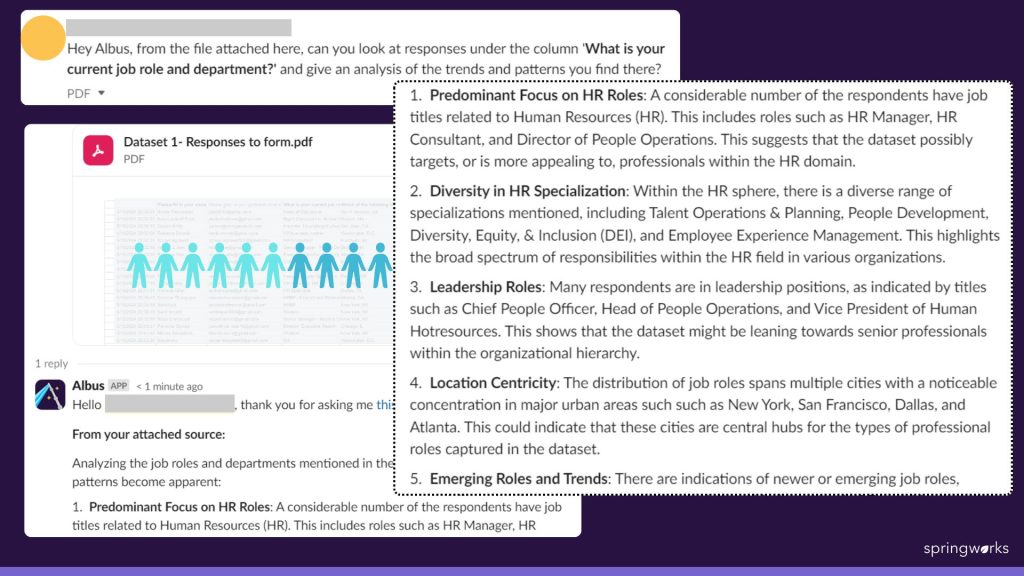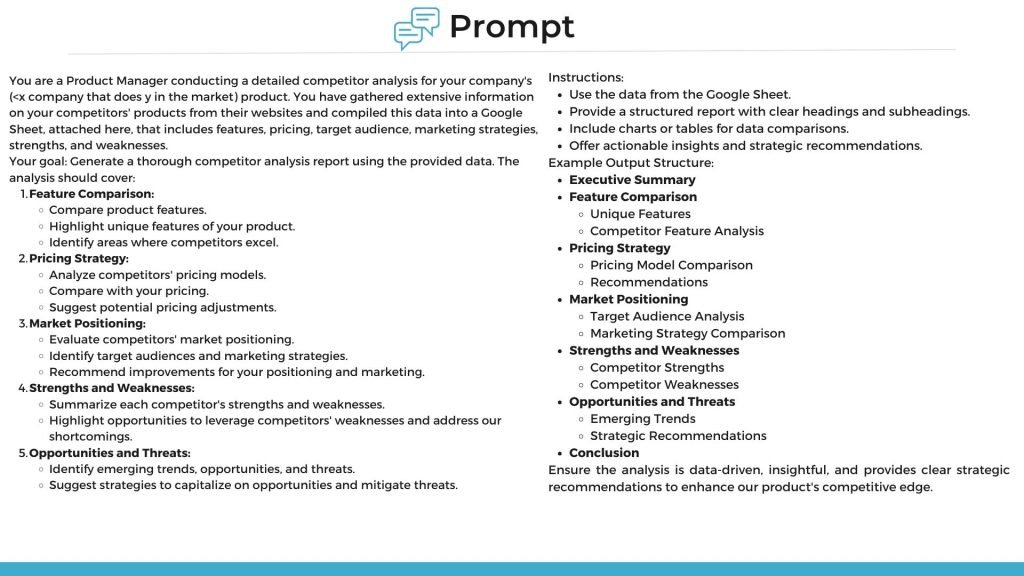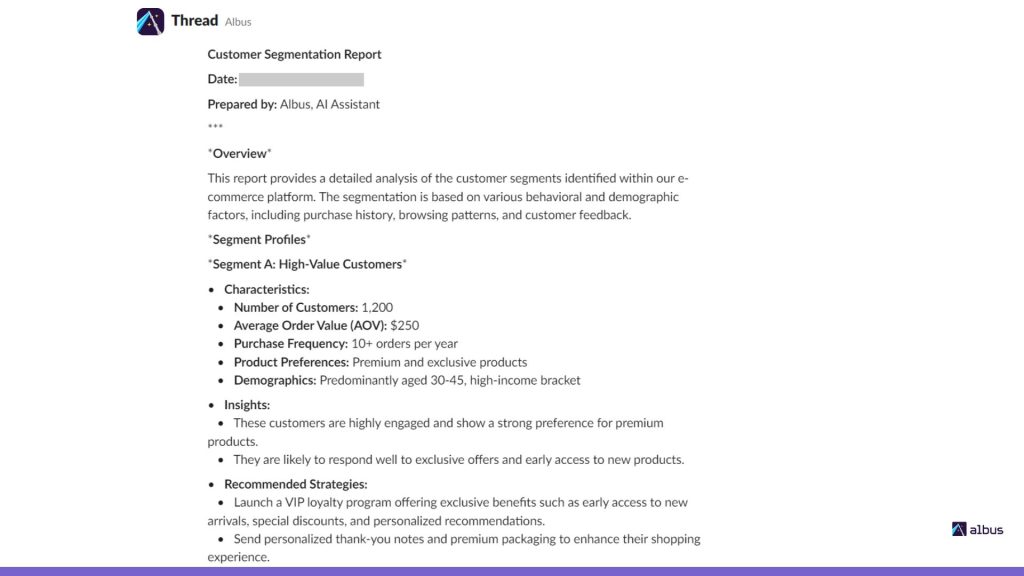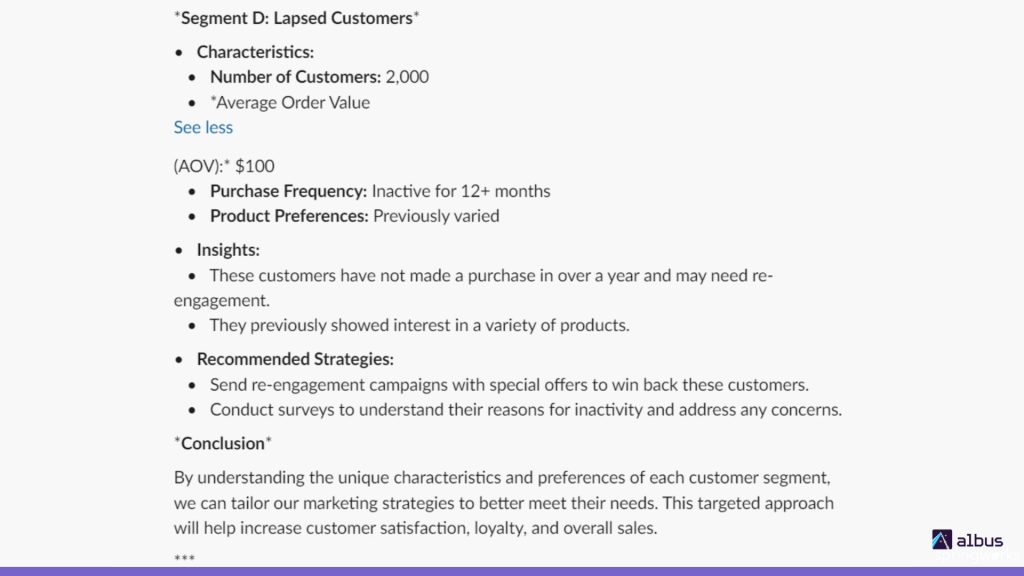AI in Product Management: A Deep Dive
Artificial Intelligence (AI) is revolutionizing work as we know it, and the field of product management is no exception.
Think of AI as that overachieving intern who never sleeps, never complains, and always gets the job done perfectly.
By integrating AI into product management, companies can make smarter, data-driven decisions, streamline their operations, and deliver superior products that not only meet market demands but also leave competitors scrambling to catch up.
Key AI Applications in Product Management
1. Product Ideation and Market Research
AI can analyze vast amounts of data from various sources, such as social media, customer reviews, and market trends, to identify gaps and opportunities.
Market Analysis
AI tools can gather and analyze market data to understand trends, customer needs, and competitive landscape. They can process and analyze large datasets to reveal emerging patterns and consumer preferences.

The example above uses an AI tool called Chat Aid.
Chat Aid is an intelligent workplace search tool that makes it easy for teams to access the information they need by building a comprehensive knowledge base from multiple sources (like Google, Slack, Hubspot, Jira, Confluence, Websites, Zapier, Notion, etc.). It is powered by GPT4 Turbo and Cohere, two of the most advanced AI technologies available today.
Competitive Analysis
AI can monitor competitors' activities, including product launches, marketing strategies, and customer feedback. This competitive intelligence helps product teams position their products more effectively in the market and provides insights into potential areas for innovation.
AI-driven platforms can analyze competitors' social media activities, product reviews, and sales data to provide a comprehensive view of their market strategies.
Methods:
Using plugins
Tools like Thunderbit can be installed from Chrome extensions and used to study competitors and conduct analysis by following these steps:
- Install the plugin
- Pick the target competitor pages
- Arrange a Google sheet with clear columns
- Run the extraction program
- Generate a report using a generative AI tool
Prompt Engineering
Prompt engineering is the process of creating and improving prompts (called 'Iterative Refinement') to get the best and most accurate answers from AI models. A model prompt for competitor analysis is shown below.
Chain-of-thought Prompting
A carefully structured, step-by-step prompting method that guides the AI tool to function similar to human reasoning and produce high-quality responses. For competitor analysis:
- Step-by-Step Analysis: Break the analysis into smaller, logical steps to ensure thoroughness. Example: Start by listing the main products of Company X. Then, describe the target market for each product. Finally, analyze the pricing strategy for these products.
- Complex Queries: Use a step-by-step approach for more complex queries that need detailed analysis. Example: Identify the key strengths of Company X. Next, compare these strengths to our company's offerings. Lastly, suggest areas where we can improve our strategy.
Zero-Shot and Few-Shot Learning
Zero-shot learning refers to a machine learning model's ability to make accurate predictions or classify data it has never seen before, based on knowledge it has learned from related tasks. Few-shot learning is a technique where an LLM is prompted with the use of relevant examples or samples, such as providing competitor analysis reports and then asking the AI to generate a similar report for a new competitor.

A model prompt for competitor analysis
(Remember to fill in the relevant details & attach the file or sheet with the competitor details)
You are a Product Manager conducting a detailed competitor analysis for your company's [product]. Analyze the following:
Feature Comparison: Compare product features. Highlight unique features of your product. Identify areas where competitors excel.
Pricing Strategy: Analyze competitors' pricing models. Compare with your pricing. Suggest potential pricing adjustments.
Market Positioning: Evaluate competitors' market positioning. Identify target audiences and marketing strategies. Recommend improvements for your positioning and marketing.
Strengths and Weaknesses: Summarize each competitor's strengths and weaknesses. Highlight opportunities to leverage competitors' weaknesses and address our shortcomings.
Opportunities and Threats: Identify emerging trends, opportunities, and threats. Suggest strategies to capitalize on opportunities and mitigate threats.
Instructions: Use the data from the Google Sheet. Provide a structured report with clear headings and subheadings. Include charts or tables for data comparisons. Offer actionable insights and strategic recommendations.
Example Output Structure: Executive Summary → Feature Comparison (Unique Features, Competitor Feature Analysis) → Pricing Strategy (Pricing Model Comparison, Recommendations) → Market Positioning (Target Audience Analysis, Marketing Strategy Comparison) → Strengths and Weaknesses (Competitor Strengths, Competitor Weaknesses) → Opportunities and Threats (Emerging Trends, Strategic Recommendations) → Conclusion
Visual Data Analysis
AI tools can also analyze visual data such as images and videos. For instance, AI can track visual trends on platforms like Instagram and Pinterest, providing insights into popular styles, colors, and aesthetics that resonate with consumers. AI-powered image recognition technologies can analyze millions of images to identify emerging visual trends that can inform product design and marketing strategies.
Product Roadmapping
AI can help plan and prioritize product features and updates based on data-driven insights, ensuring that development efforts align with market demands and business objectives.
2. Customer Insights and Personalization
Understanding customer behavior is crucial for product success. AI algorithms analyze customer data to provide deep insights into preferences, purchase patterns, and pain points.
Customer Segmentation
AI can segment customers based on behavior, demographics, and other criteria. This enables product teams to tailor their offerings to specific customer segments, enhancing product relevance and customer satisfaction.


Predictive Analytics
AI can forecast future market trends and consumer behaviors by analyzing historical data and current market conditions. This predictive capability helps product teams make informed decisions about product development and marketing strategies.
Tools like Salesforce Einstein use machine learning to predict customer needs and behaviors, enhancing personalization and customer engagement.
Statistics: According to Salesforce, 63% of service professionals believe that AI will enable them to assist their customers more swiftly, and 68% are already using it to personalize their customer communications.
3. Prototyping and Design
AI-powered design tools assist in creating innovative product designs, generating multiple design alternatives based on specified criteria, and validating ideas before full-scale development.
Generative Design
AI-driven generative design tools utilize advanced algorithms to explore a vast range of design possibilities. These tools generate numerous design options based on specific constraints and preferences, such as material properties, manufacturing methods, and functional requirements.
This approach accelerates the design process and uncovers innovative solutions that might not be immediately apparent to human designers. By evaluating a broader spectrum of possibilities, generative design ensures that the final product is optimized for performance, cost, and manufacturability.
Enhanced Creativity
AI tools like Adobe Sensei enhance designers' creativity and productivity by automating repetitive tasks and providing intelligent suggestions. For instance, these tools can automatically adjust image properties, generate design elements, and suggest layouts based on user preferences and historical data.
This allows designers to focus more on the creative aspects of their work rather than mundane tasks. Additionally, AI can analyze vast amounts of design data to provide insights and recommendations, helping designers make informed decisions quickly and effectively. This not only speeds up the design process but also enhances the quality and innovation of the final product.
4. Product Development and Testing
AI streamlines product development by automating repetitive tasks, such as coding and testing.
Automated Testing
AI-driven test automation improves accuracy and speed by creating, executing, and maintaining test cases automatically. This reduces human error, increases test coverage, and focuses on high-risk areas. It leads to faster issue detection and resolution, cutting down the time to market.
Continuous Integration and Delivery (CI/CD)
Integrating AI into CI/CD pipelines improves bug detection and resolution by analyzing code changes and predicting impacts. This ensures smoother development cycles and seamless code integration. AI also automates deployment processes, maintaining high code quality and enabling quicker software releases.
Leveraging AI for automated testing and CI/CD enhances efficiency, reduces errors, and accelerates high-quality product delivery.
Statistics: Gartner reports that AI test automation reduces testing time by 30% and boosts test coverage by 70%, cutting time-to-market by 50%. Capgemini adds that it slashes regression testing time by 90%, enabling faster software updates.
5. Demand Forecasting and Inventory Management
AI algorithms predict future demand by analyzing historical sales data, seasonal trends, and market conditions. This helps product managers optimize inventory levels, reduce stockouts and overstock situations, and ensure that products are available when and where customers want them.
Conclusion: The Future of AI in Product Management
As AI continues to evolve, its impact on product management will only grow stronger. Product managers who embrace AI as a strategic tool will be better positioned to create innovative products, streamline operations, and deliver exceptional customer experiences.
By leveraging AI for data analysis, customer insights, design, development, and forecasting, product teams can make more informed decisions, reduce time-to-market, and ultimately create products that truly resonate with their target audience.
However, it's important to remember that AI is a tool, not a replacement for human creativity and intuition. The most successful product managers will be those who can effectively combine AI-driven insights with human ingenuity to create truly exceptional products.
